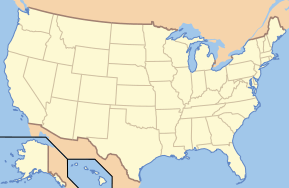Acadia National Park
| Acadia National Park | |
|---|---|
|
IUCN category V (protected landscape/seascape) | |
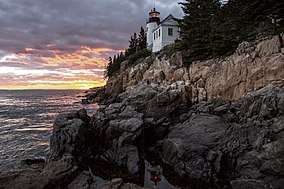 | |
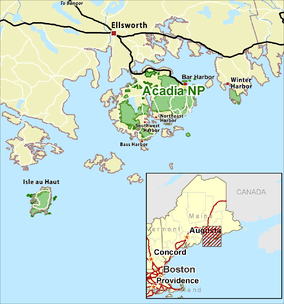 | |
| Location | Hancock / Knox counties, Maine, United States |
| Nearest city | Bar Harbor |
| Coordinates | 44°21′N 68°13′W / 44.350°N 68.217°WCoordinates: 44°21′N 68°13′W / 44.350°N 68.217°W |
| Area | 49,052 acres (198.51 km2)871 acres (352 ha) private[1] |
| Established | July 8, 1916 |
| Visitors | 3,509,271 (in 2017)[2] |
| Governing body | National Park Service |
| Website | Acadia National Park |
Acadia National Park is an American national park located in the state of Maine, southwest of Bar Harbor. The park reserves most of Mount Desert Island and its associated smaller islands along the coast of Maine. Initially designated Sieur de Monts National Monument by presidential proclamation in 1916,[3][4] the park was renamed and redesignated as Lafayette National Park in 1919.[5][6] The park was renamed Acadia National Park in 1929.[5]
More than 3.5 million people visited the park in 2017.[2] Acadia National Park is the oldest national park in the United States east of the Mississippi River and is the only one in the Northeast United States.
History
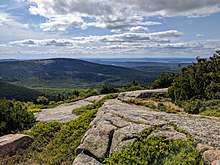
The area was originally inhabited by the Wabanaki people.[7]
While he was sailing down the coast of what is now Maine on 5 September 1604,[8] Samuel de Champlain observed a large inshore island. He wrote:
"That same day we also passed near an island about four or five leagues [19 to 24 km] in length, off which we were almost lost on a little rock, level with the surface of the water, which made a hole in our pinnace close to the keel. The distance from this island to the mainland on the north is not a hundred paces. It is very high and cleft in places, giving it the appearance from the sea of seven or eight mountains one alongside the other. The tops of them are bare of trees, because there is nothing there but rocks. The woods consist only of pines, firs, and birches." He named it Mount Desert Island.[9]
Over four centuries later, the area remains essentially the same.[10]
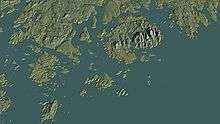
The first French Missionary colony in America was established on Mount Desert Island in 1613. The colony was destroyed a short time later by an armed vessel from the Colony of Virginia as the first act of overt warfare in the long struggle leading to the French and Indian Wars. The island was granted to Antoine de la Mothe Cadillac by Louis XIV of France in 1688, but ceded to England in 1713. Massachusetts governor Sir Francis Bernard, 1st Baronet assumed control of the island in 1760. In 1780, Massachusetts granted the eastern half of the island to Cadillac's granddaughter, Mme. de Gregoire, while Bernard's son John retained ownership of the western half. The first record of summer visitors vacationing on the island was in 1855, and steamboat service from Boston was inaugurated in 1868. The scenic Green Mountain Cog Railway was built from the shore of Eagle Lake to the summit of Cadillac Mountain in 1888, and in 1901 the Maine Legislature granted Hancock County a charter to acquire and hold land on the island in the public interest. The first land was donated by Mrs. Eliza Homans of Boston in 1908, and 5,000 acres (2,000 ha) had been acquired by 1914.[8]
Beginnings
The landscape architect Charles Eliot is credited with the idea for the park.[11] George B. Dorr, called the "Father of Acadia National Park," along with Eliot's father Charles W. Eliot (president of Harvard from 1869 to 1909), supported the idea both through donations of land and through advocacy at the state and federal levels. It first attained federal status when President Woodrow Wilson established it as Sieur de Monts National Monument on July 8, 1916, administered by the National Park Service. On February 26, 1919, it became a national park, with the name Lafayette National Park in honor of the Marquis de Lafayette, an influential French supporter of the American Revolution. Jordan Pond Road was started in 1922 and completed as a scenic motor highway in 1927. The name of the park was changed to Acadia National Park on January 19, 1929, in honor of the former French colony of Acadia which once included Maine. Schoodic Peninsula was added to the park in 1929; and the Cadillac Mountain Summit Road, begun in 1925, was completed in 1931.[8]
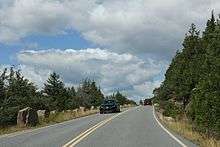
From 1915 to 1933, the wealthy philanthropist John D. Rockefeller, Jr. financed, designed, and directed the construction of a network of carriage trails throughout the park. He sponsored the landscape architect Beatrix Farrand, with the nearby family summer home Reef Point Estate, to design the planting plans for the subtle carriage roads at the park (c. 1930).[12] The network encompassed over 50 miles (80 km) of gravel carriage trails, 17 granite bridges, and two gate lodges, almost all of which are still maintained and in use today. Cut granite stones placed along the edges of the carriage roads act as guard rails of sort and are locally known as "coping stones" to help visitors cope with the steep edges. They are also known as "Rockefeller's Teeth".[13]
Acadia National Park's first naturalist, Arthur Stupka, also had the distinction of being the first NPS naturalist to serve in any of the NPS's eastern United States districts. He joined the park staff in 1932, and in the capacity of park naturalist he wrote, edited and published a four-volume serial entitled Nature Notes from Acadia (1932–1935).[14]
Fire of 1947
Beginning on October 17, 1947, 10,000 acres (4,000 ha) of Acadia National Park burned in a fire that began along the Crooked Road several miles west of Hulls Cove.[15] The forest fire was one of a series of fires that consumed much of Maine's forest as a result of a dry year. The fire burned until November 14, and was fought by the Coast Guard, Army, Navy, local residents, and National Park Service employees from around the country. Restoration of the park was supported, substantially, by the Rockefeller family, particularly John D. Rockefeller, Jr. Regrowth was mostly allowed to occur naturally and the fire has been suggested [16] to have actually enhanced the beauty of the park, adding diversity to tree populations and depth to its scenery.
Friends of Acadia
In 1986, a group of Acadia-area residents and park volunteers formed the membership-based nonprofit organization Friends of Acadia for the purpose of organizing volunteer effort and private philanthropy for the benefit of Acadia National Park. The group's first major achievement was a $3.4 million endowment to maintain the park's 44-mile (71 km) carriage road system in perpetuity, which leveraged federal funds to fully restore the road system. Subsequent projects and partnerships included Acadia Trails Forever, making Acadia the first national park with an endowed trail system; the Island Explorer, a free, propane-powered bus system serving the park and local communities; and youth initiatives such as the Acadia Youth Technology Team, which engages local teens to help their peers connect with the park and develop the next generation of park stewards.[17]
Schoodic Education and Research Center
In 2002, the National Park Service acquired the former naval base located in the Schoodic Peninsula District of Acadia National Park, and renovated it into the Schoodic Education and Research Center (SERC). SERC is one of about 20 National Park Service research learning centers in the United States, and is the largest of all these facilities. It is dedicated to supporting the scientific research in the park, providing professional development for teachers, and educating students to become a new generation of stewards who will help conserve our natural and cultural treasures.[18]
Terrain and features
The park includes mountains, an ocean shoreline, woodlands, and lakes. In addition to Mount Desert Island, the park comprises much of the Isle au Haut, parts of Baker Island, and a portion of the Schoodic Peninsula on the mainland.
In total, Acadia National Park consists of 49,052 acres (19,851 ha),[5] including 30,300 acres (12,300 ha) on Mount Desert Island, 2,728 acres (1,104 ha) on Isle au Haut and 2,366 acres (957 ha) on the Schoodic Peninsula. The permanent park boundary, as established by act of Congress in 1986, includes a number of private in-holdings that the park is attempting to acquire.
Cadillac Mountain, named after the French explorer Antoine Laumet de La Mothe, sieur de Cadillac, is on the eastern side of the island. Its green, lichen-covered, pink granite summit is, because of a combination of its eastern location and height, one of the first places in the United States to see the sunrise. Miles of carriage roads were originally built by John D. Rockefeller, Jr. The mountains of Acadia National Park offer hikers and bicycle riders views of the ocean, island lakes, and pine forests.
The inlet Somes Sound, often described as the "only fjord on the East Coast",[19] is now called a fjard by officials.[20][21]
There are 26 significant mountains in the park, ranging from 284 feet (Flying Mountain) to 1,530 feet (Cadillac Mountain).[22] Cadillac is often called the tallest mountain on the North Atlantic seaboard, although the term "seaboard" does not have an official definition.[23]
Geology

The Cadillac Mountain Intrusive Complex is part of the Coastal Maine Magmatic Province, consisting of over a hundred mafic and felsic plutons associated with the Acadian Orogeny. Mount Desert Island bedrock consists mainly of Cadillac Mountain granite. Perthite lends itself to the granite's pinkish color. The Silurian age granite ranges from 424 to 419 million years ago. Diabase dikes trend north-south through the complex. Almost 300 million years of erosion followed before the deposition of glacial features during the Pleistocene. These include glacial polish, glacial striations, and chatter marks. Other features include The Bubbles, two Rôche moutonnées, and the U-shaped valleys of Sargent Mountain Pond, Jordan Pond, Seal Cove Pond, Long Pond, Echo Lake and Eagle Lake. Somes Sound is a fjard and terminal moraines form the southern end of Long Pond, Echo Lake, and Jordan Pond. Finally, Bubble Rock is an example of a glacial erratic.[24]
Wildlife
The park is home to some 40 different species of mammalian wildlife. Among these are red and gray squirrels, chipmunks, snowshoe hares, white-tailed deer, moose, beavers, porcupines, minks, muskrats, foxes, raccoons, coyotes, bobcats, and black bears. Many other marine species have been observed in the surrounding area and waters.
Each summer several trails in the park are closed to protect nesting peregrine falcons. Other birds that are present in this park are golden eagles, various owls, various hawks, and bald eagles.
Excavations of old Indian sites in the Mount Desert Island region have yielded remains of the native mammals. Bones of wolf, beaver, deer, elk, gray seal (Halichoerus grypus), the Indian dog, and the extinct sea mink (Neovison macrodon), as well as large numbers of raccoon, lynx, wolf, muskrat, and deer.[25] Although beaver were trapped to extinction on the island, two pairs of beaver that were released in 1920 by George B. Dorr at the brook between Bubble Pond and Eagle Lake have repopulated it. The large fire in 1947 cleared the eastern half of the island of its coniferous trees and permitted the growth of aspen, birch, alder, maple and other deciduous trees which enabled the beaver to thrive.[26]
Species that used to inhabit the island include the cougar and the gray wolf. Zoologists believe these predators left the area due to a dramatic decrease in small prey and proximity to human activity.
Plants
Despite its small size (Acadia National Park covers less than one percent of Maine's land area) the park is known to harbor over 50 percent of the vascular plants occurring in Maine.[27] Plant, algae, and fungi specimens collected during research activities at Acadia National Park are deposited for future study at a herbarium jointly administered by the park and College of the Atlantic. A special garden called The Wild Gardens of Acadia was established in 1961 in the Sieur de Monts area of the park and has since grown to include more than 400 indigenous plant species found throughout all park areas.[28]
Gallery
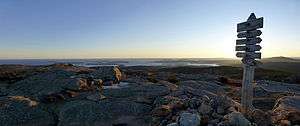 From Mt. Penobscot
From Mt. Penobscot Jordan Pond and the Bubbles (the two hills in the distance)
Jordan Pond and the Bubbles (the two hills in the distance) Otter Cove
Otter Cove- Echo Lake Beach

 Thunder Hole
Thunder Hole
See also
- List of birds of Acadia National Park
- List of national parks of the United States
- Bass Harbor Head Light
- Blackwoods Campground
- College of the Atlantic
- Great Head Trail
- Isle au Haut
- National Register of Historic Places listings in Acadia National Park
- Towns on Mount Desert Island:
- Winter Harbor (Schoodic Peninsula)
References
- ↑ "Listing of acreage as of December 31, 2011". Land Resource Division, National Park Service. Retrieved 2011-05-06.
- 1 2 "NPS Annual Recreation Visits Report". National Park Service. Retrieved 2018-02-23.
- ↑ A Proclamation by President Woodrow Wilson on July 8, 1916. 39 Stat. 1785
- ↑ "Sieur de Monts Spring". nps.gov. National Park Service. September 26, 2016. Retrieved December 10, 2017.
- 1 2 3 "Park Statistics". National Park Service. Retrieved 2010-07-25.
- ↑ An Act To establish the Lafayette National Park in the State of Maine. Pub.L. 65–278, 40 Stat. 1178, enacted February 26, 1919.
- ↑ Commissioned by the National Park Service, a 2-volume report "Asticou's Island Domain: Wabanaki Peoples at Mount Desert Island 1500–2000" (2007) was authored by Harald E.L. Prins and Bunny McBride. This digital text detailing Acadia National Park’s cultural and natural history is freely accessible NPS.gov
- 1 2 3 Cammerer, Arno B. (1934). Acadia National Park. Washington DC: United States Government Printing Office.
- ↑ Canadian-American Center Cartography Studio. "Champlain and the Settlement of Acadia 1604-1607". University of Maine. Retrieved 6 February 2014.
- ↑ "Acadia National Park: Mount Desert Island". Trails.com / Demand Media. Retrieved 2010-01-16.
- ↑ "History of Acadia". Acadia Net, Inc. November 1995. Archived from the original on 2009-04-01. Retrieved 2009-07-25.
- ↑ Jane Brown (1995-03-01). Beatrix: the gardening life of Beatrix Jones Farrand, 1872–1959. Viking Press. p. 208. ISBN 0-670-83217-0.
- ↑ Schmitt, Catherine (2016). History Acadia National Park: The Stories Behind One of America's Great Treasures. Connecticut: Lyons Press. p. 130. ISBN 9781493018130.
- ↑ "DigitalCommons@UMaine – Advanced Search title:( Nature Notes from Acadia )". The University of Maine. Retrieved June 6, 2017.
- ↑ "Fire of 1947". National Park Service. Archived from the original on 30 August 2010. Retrieved 2010-07-25.
- ↑ "Fire of 1947 - Acadia National Park (U.S. National Park Service)". www.nps.gov.
- ↑ "Friends of Acadia - Maine Nonprofit, Conservation Organization, Acadia National Park, Bar Harbor". Friends of Acadia.
- ↑ http://www.nps.gov/acad/serc.htm
- ↑ Debbie Harmsen (2008). Maine Coast. Random House. p. 248. ISBN 978-1-4000-1904-5. Retrieved 2010-07-25.
- ↑ "Somes Sound, Mount Desert Island". Maine Geological Survey. November 1998. Retrieved 2010-07-25.
- ↑ "The Story of Glaciers" (PDF). EarthCache Program. National Park Service. Retrieved 2010-07-25.
- ↑ "The 26 peaks of Acadia National Park". Acadia on My Mind. Retrieved 14 August 2018.
- ↑ "Cadillac Mountain". Acadia Magic. Retrieved 14 August 2018.
- ↑ Graham, J. (2010). Acadia National Park: geologic resources inventory report. Natural Resource Report NPS/NRPC/GRD/NRR—2010/232. Ft. Collins: United States Park Service. pp. 1–63.
- ↑ Richard H. Manville (November 1941). "Notes on the Mammals of Mount Desert Island, Maine". Journal of Mammalogy. 23 (4): 391–398. doi:10.2307/1375049. JSTOR 1375049.
- ↑ D. Muller-Schwarze, Susan Heckman (1980). "The Role of Scent Marking in Beaver". Journal of Chemical Ecology. 6: 81–95. doi:10.1007/BF00987529. Retrieved 2010-09-04.
- ↑ Harris, Tanner; Nishanta Rajakaruna; Sarah J. Nelson; Peter D. Vaux (2012). "Stressors and threats to the flora of Acadia National Park, Maine: Current knowledge, information gaps, and future directions". Journal of the Torrey Botanical Society. 139 (3): 323–344. doi:10.3159/torrey-d-11-00086.1.
- ↑ "The Wild Gardens of Acadia - Friends of Acadia". friendsofacadia.org.
External links
| Wikimedia Commons has media related to Acadia National Park. |
| Wikivoyage has a travel guide for Acadia National Park. |

